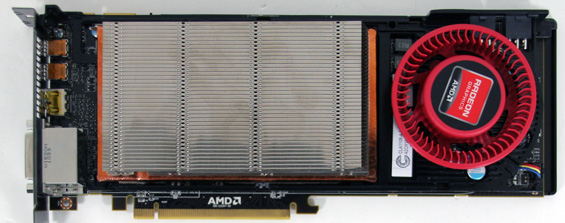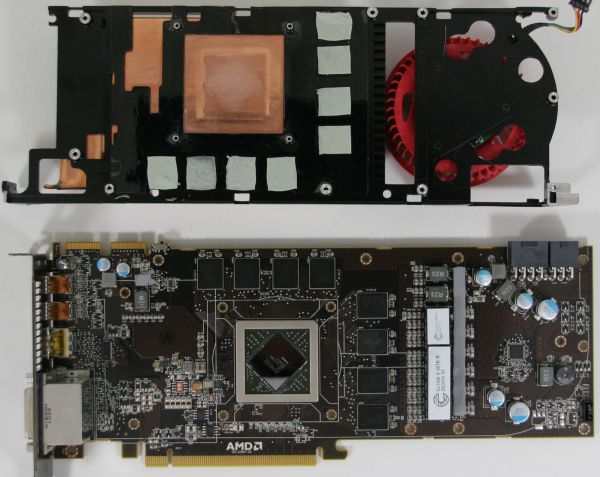AMD's Radeon HD 6970 & Radeon HD 6950: Paving The Future For AMD
by Ryan Smith on December 15, 2010 12:01 AM ESTMeet the 6970 & 6950
Now that we’ve finally looked at what makes the 6900 series tick, let’s look at the cards themselves.
If you’re familiar with the 6800 series, then the 6900 series is nearly identical. For our reference cards AMD is using the same style they used for the 6800 cards, utilizing a completely shrouded and squared off design. Furthermore unlike the 5800 series AMD is utilizing the same cooler/PCB/layout for both the 6970 and 6950, meaning virtually everything we have to say about one card applies to the other as well. In this case we’ll be using the 6970 as our point of reference.
Starting with the length, the 6970 measures a hair over 10.5”, giving it the same length as the 5870. Buyers looking for a 5850-like shorter card will have to look elsewhere else for the moment, as the 6950 is the same 10.5”. Power is provided by a set of 6+8pin PCIe power sockets at the top of the card, necessary as the 6970’s 250W TDP is in excess of the 225W 6+6 limit. The 6950 on the other hand does use 6+6 PCIe power sockets in the same location, afforded by its lower 200W TDP.
Cracking open the 6970 we find the PCB with the Cayman GPU at the center in all its 389mm2 glory. Around it are 8 2Gb Hynix GDDR5 chips, rated for 6Gbps, 0.5Gbps higher than what the card actually runs at. As we’ve said before the hardest part about using GDDR5 at high speeds is the complexity of building a good memory bus, and this continues to be the case here. AMD has made progress on getting GDDR5 speeds up to 5.5Gbps primarily through better PCB designs, but it looks like hitting 6Gbps and beyond is going to be impractical, at least for a 256bit bus design. Ultimately GDDR5 was supposed to top out at 7Gbps, but with the troubles both AMD and NVIDIA have had, we don’t expect anyone will ever reach it.
Moving on to the cooling apparatus, vapor chamber coolers are clearly in vogue this year. AMD already used a vapor chamber last year on the dual-GPU 5970, while this year both AMD and NVIDIA are using them on their high-end single-GPU products. Compared to a more traditional heatpipe cooler, a vapor chamber cooler is both more efficient than a heatpipe cooler and easier to build in to a design as there’s no need to worry about where to route the heatpipes. Meanwhile airflow is provided by a blower at the rear of the card; compared to the 5870 the blower on the 6970 is just a bit bigger, a fair consideration given that the 6970 is a hotter card. Interestingly in spite of the higher TDP AMD has still been able to hold on to the half-height exhaust port at the front of the card.

As for I/O we’re looking at AMD’s new port layout as seen on the 6800 series: 2x DVI, 1x HDMI 1.4, and 2x mini-DP. All together the 6970 can drive up to 6 monitors through the use of the mini-DP ports and a MST hub. Compared to the 5800 series the DVI-type ports have a few more restrictions however; along with the usual limitation of only being able to drive 2 DVI-type monitors at once, AMD has reduced the 2nd DVI port to a single-link port (although it maintains the dual-link pin configuration), so you won’t be able to drive 2 2560 or 3D monitors using DVI ports.

Elsewhere the card features 2 CrossFire connectors at the top, allowing for tri-CF for the particularly rich and crazy. Next to the CF connectors you’ll find AMD’s not-so-secret switch, which controls the cards’ switchable BIOSes. The card has 2 BIOSes, which can be changed with the flick of a switch. The primary purpose of this switch is to offer a backup BIOS in case of a failed BIOS flash, as it’s possible to boot the card with the secondary BIOS and then switch back to the primary BIOS after the computer has started in order to reflash it. Normally AMD doesn’t strike us as very supportive of BIOS flashing, so this is an interesting change.

The BIOS Switch
Like the 5870 the back side is covered with a metal plate, and while there aren’t any components on the back side of the card to protect, this is a nice touch by making it easier to grab the card without needing to worry about coming in contact with a pointy contact.
Finally, while the card’s overall dimensions are practically identical to the 5870, we noticed that the boxy design isn’t doing AMD any favors when it comes to CrossFire mode with 2 cards right next to each other. The 5870’s shroud actually jutted out just a bit at the center, keeping the ventilation hole for the blower from pressing right up against the back of another card. The 6970 does not have this luxury, meaning it’s possible to practically seal the upper card depending on how you screw the cards down. As a result our CF temperatures run high, but not to a troublesome degree. We’d still encourage AMD to take a page from NVIDIA’s book and to bring the shroud in a bit around the blower so that it has more room to breathe, particularly as their TDP is approaching NVIDIA’s. In the meantime we’d definitely suggest spacing your cards apart if you have a motherboard and case that allows it.













168 Comments
View All Comments
529th - Sunday, December 19, 2010 - link
Great job on this review. Excellent writing and easy to read.Thanks
marc1000 - Sunday, December 19, 2010 - link
yes, that's for sure. we will have to wait a little to see improvements from VLIW4. but my point is the "VLIW processors" count, they went up by 20%. with all other improvements, I was expecting a little more performance, just that.but in the other hand, I was reading the graphs, and decided that 6950 will be my next card. it has double the performance of 5770 in almost all cases. that's good enough for me.
Iketh - Friday, December 24, 2010 - link
This is how they've always reviewed new products? And perhaps the biggest reason AT stands apart from the rest? You must be new to AT??WhatsTheDifference - Sunday, December 26, 2010 - link
the 4890? I see every nvidia config, never a card overlooked there, ever, but the ATI's (then) top card is conspicuously absent. long as you include the 285, there's really no excuse for the omission. honestly, what's the problem?PeteRoy - Friday, December 31, 2010 - link
All games released today are in the graphic level of the year 2006, how many games do you know that can bring the most out of this card? Crysis from 2007?Hrel - Tuesday, January 11, 2011 - link
So when are all these tests going to be re-run at 1920x1080 cause quite frankly that's what I'm waiting for. I don't care about any resolution that doesn't work on my HDTV. I want 1920x1080, 1600x900 and 1280x720. If you must include uber resolutions for people with uber money then whatever; but those people know to just buy the fastest card out there anyway so they don't really need performance numbers to make up their mind. Money is no object so just buy nvidia's most expensive card and ur off.AKP1973 - Thursday, October 13, 2011 - link
Have you guys noticed the "load GPU temp" of the 6870 in XFIRE?... It produced so very low heat than any enthusiast card in a multi-GPU setup. That's one of the best XFIRE card in our time today if you value price, performance, cool temp, and silence.!Travisryno - Wednesday, April 26, 2017 - link
It's dishonest referring to enhanced 8x as 32x. There are industry standards for this, which AMD, NEC, 3DFX, SGI, SEGA AM2, etc..(everybody) always follow(ed), then nVidia just makes their own...Just look how convoluted it is..